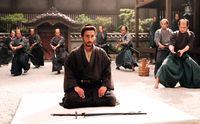MOVIE REVIEW
Hara-Kiri: Death of a Samurai (2011)
The ticket-holder line for the Vancouver International Film Festival special screening of Takashi Miike’s 3-D “Hara-Kiri: Death of a Samurai” snaked around the corner of the theater even in the miserable Vancouver drizzle. But these weren’t the typical Miike fanboys. Many were middle-aged and chatted about their fond memories of Masaki Kobayashi’s 1962 masterpiece, “Harakiri.” They wondered how this remake would measure up with caution in their voices: “It’s like remaking ‘The Godfather’.” For a film rarely mentioned outside critical circles compared to other Japanese films of the era, “Harakiri” — aided by Tatsuya Nakadai’s performance — developed a devoted following among cinephiles and even casual fans of Japanese cinema.
Not to worry. Nothing in Mr. Miike’s “Death of a Samurai” either outshines or detracts from the original (if a remake is capable of such a thing in the first place). It is a more than respectable and occasionally inspired effort. “Death of a Samurai” follows ronin Hanshiro Tsugumo (Ebizo Ichikawa) and his family scraping by in the peaceful days of the Edo period, which leaves many samurai without posts and destitute. The circumstances have driven some ronin make insincere requests to commit seppuku at the ruling lord's estate while actually hoping to receive charity or employment from sympathetic retainers. The film begins with Tsugumo requesting an audience for his seppuku to head retainer of the house of Li, Kageyu (Koji Yakusho), and hearing the cautionary tale of Chijiiwa Motome (Eita) — a ronin who was called on his bluff — to serve as a particularly grisly example to others. Yet Tsugumo is already intimately aware of Motome’s fate, and his appearance at the house of Li is the endgame in an ongoing revenge plot.
“Death of a Samurai” is bookended by powerful opening and closing scenes. The titular suicide of Motome’s death at the blunt business end of a bamboo sword is gut-wretching even as the otherwise beautiful tranquility of the lord's courtyard is emphasized through the visual depth of 3-D cinematography. The last few lines are a stinging condemnation of the ruling classes’ rote formality and empty rituals. (Japan kitsch perhaps? Apologies to Milan Kundera.) But of course, unflinching physical violence and social impudence are what Mr. Miike is best at. It is the middle of the film — which fills in the narrative with flashbacks — that feels a bit flaccid. “Death of a Samurai” suffers from its inability to sustain this incisive critique, which would give much-needed edge and focus to the lengthy recounting of Tsugumo’s family misfortunes. This flaw reinforces the original’s brilliance at being able to generate such powerful affect without veering into the easy melodrama that this version does at times, aided by Ryuichi Sakamoto’s inconsistent and occasionally cloying score. In wanting to respect the gravity of the narrative, it is as if Mr. Miike restrained his normally exuberant filmmaking style a little too much. Similarly, while it’s refreshing that the 3-D was not used as a novelty or as a stylistic shortcut for modernizing a classic film in the way that Takeshi Kitano’s “The Blind Swordsman: Zatoichi” overused C.G.I. blood, it’s not clear that — apart from one or two scenes — the 3-D added anything to the film at all.
Still, “Hara-Kiri: Death of a Samurai” has a lot to offer with its rumination of the sublime moments and inconceivable tragedies of this fallen family of the samurai caste, gorgeous cinematography and use of color. Mr. Ichikawa is excellent as Hanshiro, who must simultaneously convey the essences of doting father and fierce avenger. He’s even compelling during his brief lapses into Nakadai impersonation, all bug-eyed stares and growling line delivery. As representative for the house of Li, Mr. Yakusho’s reliable gravitas and nuanced performance keep the character from being written off as a mere villain caricature. Newcomers Eita and Hikari Mitsushima (as Tsugumo’s daughter) also make strong impressions and portray a warm and believable rapport with Mr. Ichikawa during the family scenes in the second act.

Comments